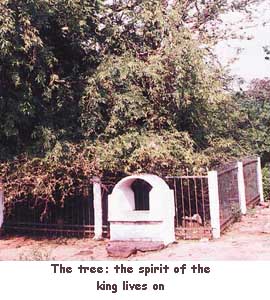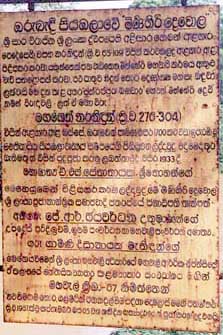

![]()
Orubendi Siyambalawe, a tamarind tree on the Elahara- Bakamuna roadside is reputed to be the fourth oldest tree in the world, being according to records over 1,700 years in age. This tree is also part of the declared world heritage . Dilrukshi Handunnetti reports.
On our way to the picturesque Knuckles range, on the Polonnaruwa- Habarana road, a certain stately and imposing tree caught our attention.
 The
tree has always been a sort of mysterious giant, and passers-by would often
stop their vehicles to drop a coin into the small till at the "devale"
next to the magnificent tree, or offer a short prayer. Villagers never
pass the area without offering a prayer or wild flowers which are found
in abundance here.
The
tree has always been a sort of mysterious giant, and passers-by would often
stop their vehicles to drop a coin into the small till at the "devale"
next to the magnificent tree, or offer a short prayer. Villagers never
pass the area without offering a prayer or wild flowers which are found
in abundance here.
Orubendi Siyambalawe a Siyambala tree, is considered to be the world's fourth most ancient tree.
It is the second such tree found in Sri Lanka. It is accepted that the world's most ancient tree is the Sri Maha Bodhi in Anuradhapura which is over 2,500 years old. Orubendi Siyam-balawe as it is known, comes fourth, being according to records over 1,700 years in age. This tree is also part of the declared world heritage despite it receiving scant attention, and its historical significance hardly being known to the public.
There are two routes to reach the Orubendi Siyambalawe.
The shortest is to travel on the Polonnaruwa-Habarana route, and to take the turn from Bakamuna.
The magnificent tree is found on the Elahara- Bakamuna roadside. From Matale, this place can be reached by travelling on the Matale- Dambulla road and turning from Naula, a 25 km drive.
Legend says that King Mahasen's spirit dwells near the tree, which is why the villagers worship the tree and have also constructed a small shrine room. To these villagers, the spirit of this able king is important. Being farmers, they are still dependent on the ancient irrigation systems, and King Maha-sen's name is respectfully mentioned in the Mahawamsa as a ruler who irrigated the North Central Province.
According to historians, the Elahara (or lesser known as Alisara) was constructed by King Wasabha (65-109 A.D.), and was subsequently rehabilitated by Mahasen (276-304 A.D.).
The villagers relate various mythical stories with conviction, woven around Mahasen, affectionately referred to as 'Minneri Deviyo' or 'Sath Rajjuru Bandara.'
It is believed that the king had certain powers which he used for the welfare of the country, and that he was able to employ devils for the reconstruction work and for deviating the anicuts.
Orubendi Siyam-balawe is the tree which Mahasen was supposed to have used to tie up his canoe, and the various rope marks evident in the splintering ancient tree are according to legend, the marks created by the rope.
Thus Mahasen to the villagers, is the deity watching over the Minneriya area, the pride of ancient Raja Rata.
The tree today shows evidence of inevitable decay, with splinters peeling from it.
Nevertheless, there are tiny roots just coming out, with the persistent rain giving the tree a greener hue.
 Sri
Lanka's first premier D.S.Senanayake had reconstructed the devale and given
a temporary protection to the invaluable tree. The late Gamini Dissanayake
had donated a massive 'Dolosmahe Pahana' to the devale, and helped construct
a shrine room for Buddhists.
Sri
Lanka's first premier D.S.Senanayake had reconstructed the devale and given
a temporary protection to the invaluable tree. The late Gamini Dissanayake
had donated a massive 'Dolosmahe Pahana' to the devale, and helped construct
a shrine room for Buddhists.
For many years, the tree has been in a neglected state. Today, the Siyambala tree is surrounded by an iron fence. People gather on a daily basis to pay homage to the spirit of Mahasen. To the farmers, worshipping king Mahasen and appealing to his spirit for a better harvest is a semi religion.
Being a Friday, the devale was not open to the worshippers when we visited Orubendi Siyambalawa. It is kept open on Wednesdays and Saturdays which are considered to be the days on which the spirits assist human beings in various forms. On such days, small poojas are offered to the tree and devale both. It is believed that the only authentic portrait of Mahasen is kept inside the shrine room.
Raja Rata with its mysterious appeal and distinct sub culture, has several cultural ceremonies which are confined to the people of the area.
'Aluth Sahal Mangallaya' is a festival celebrated by the cultivators, when they offer something from their harvest to the protective deities.
A similar offering is made to the little devale near the ancient tree, in memory of a great king who did Lanka proud, long before the West learnt the rudiments of irrigation planning.
Continue to Plus page 4 * Fighting to keep tradition alive
Return to the Plus contents page
![]()
| HOME PAGE | FRONT PAGE | EDITORIAL/OPINION | NEWS / COMMENT | BUSINESS
Please send your comments and suggestions on this web site to
info@suntimes.is.lk or to
webmaster@infolabs.is.lk